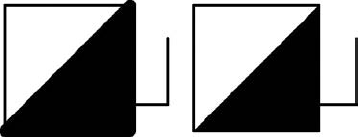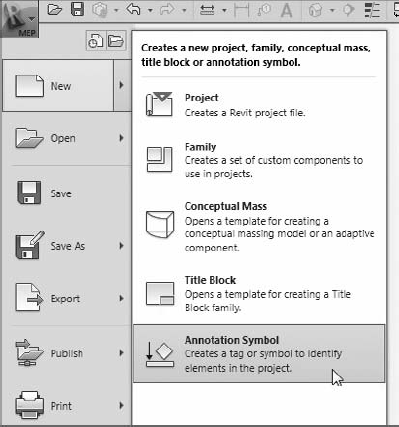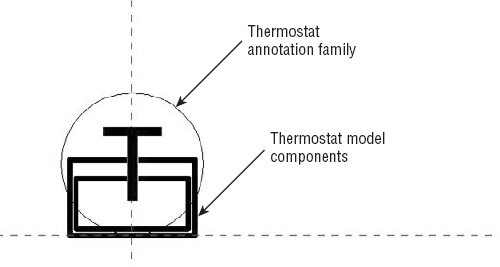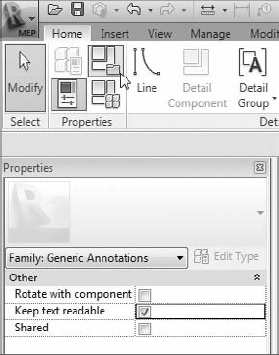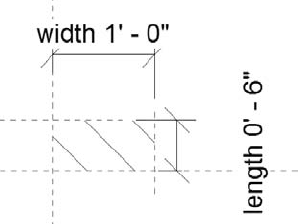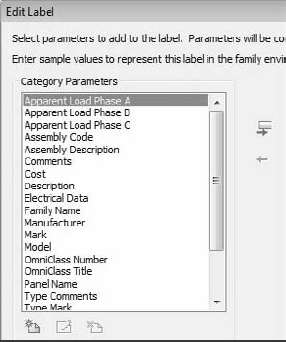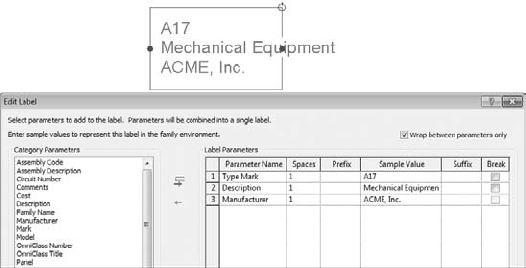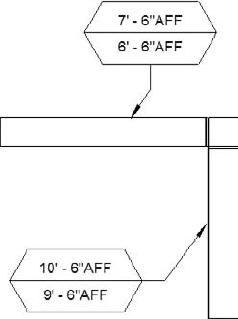Many of the components of an MEP design are represented on drawings as symbols. Having a well-stocked library of symbols can improve your efficiency in creating device families and reduce the time spent on drafting tasks. Symbols can also be used to create project legends that can be utilized on different project types when required.
Companies have spent many hours and significant funds to develop and maintain their drafting standards. Many think it is important to create construction documents that are recognizable as their work. Annotation styles and symbols can be created in Revit format in order to make the transition to Revit MEP 2011 without losing the signature look of your company construction documents.
Having a good understanding of how annotative objects can be used in Revit MEP 2011 will allow you to easily optimize content and create documents that align with your company standards.
In this chapter, you will learn to
Create symbolic lines and filled regions
Use symbols within families for representation on drawings
Work with constraints and parameters for visibility control
Use labels to create tags
It is easy to assume that because Revit MEP 2011 is a BIM solution that it does not have very good tools for drafting tasks. The truth is the drafting tools available in Revit MEP 2011 are quite useful for creating symbolic line work, hatch patterns, and annotation objects. Becoming proficient with these tools will greatly reduce your need to rely on a CAD application for drafting tasks. The more work you do in Revit MEP 2011, the less work you'll have to do in multiple applications, which will increase efficiency and will make managing standards and content easier.
The drafting tools available for use when drawing in a project view are the same as those available in the Family Editor. These tools appear on the Draw panel of the contextual tab when you click the Detail Lines button, Line button, Symbolic Lines button, or Model Lines button depending on what type of file you are working in. The image shown here is of the Draw panel because it appears on the Modify | Place Detail Lines contextual tab when the Detail Lines button on the Annotate tab is clicked.

You can use the buttons in this panel to draw lines or shapes. Clicking a button for the type of line or shape to be drawn will activate different options for setting conditions for the line work on the Options Bar, depending on what is to be drawn. The Line Style panel contains a drop-down that is populated with line styles that are defined in the file.
When you click the Line button
By holding down the Shift key while you are drawing a line, you will force it to snap to the orthogonal axis. The temporary dimensions allow you to see the length and angle of the line you are drawing. You can type in a length to automatically set the length of a line. You change the angle of a line by selecting it and editing the temporary angle dimension. You can also use the Drag Line End grips that appear when you click a line to change the length and/or angle.
When lines are drawn with Revit and they are connected at their end points, the end points remain connected when either of the lines is moved. There is no stretch command in Revit because lines maintain their connections at end points. You can select the Rectangle button
There are two buttons on the panel for drawing polygons, one for a polygon inscribed in a circle
To move or edit a shape as a whole, you must select all the lines that make up the shape. This is easily done by a selection window or by placing your mouse pointer over one of the lines and then pressing the Tab key until all the lines are highlighted for selection. Once you have selected a shape, the grips at the end points can be used to edit the shape without breaking the connection of the lines. Figure 18.1 shows two rectangles that have been edited. The rectangle on the left was edited by selecting the line on the right side and dragging the line's end point. The one on the right was edited by selecting the entire shape and dragging the end point in the upper-right corner.
The Circle button
The temporary dimension for the radius remains on the screen after you click to set the radius. You can then click the temporary dimension to edit the radius of the circle. When you click a circle that has been drawn, the Drag Line End grip that appears can be dragged to set the size of the circle. The Options Bar also has a radius option to set the size of the circle prior to selecting a center point.
There are four buttons on the Draw panel for drawing arcs. The first two are for drawing arcs whether or not they are connected to any other type of line work, while the other two are for drawing specific types of arcs that relate to lines.
The Start-End-Radius Arc button
The Center-Ends Arc button
The Tangent End Arc button
The Fillet Arc button
The Spline button
The Ellipse button
The Partial Ellipse button
The Pick Lines button
Filled regions are very useful in the symbols that represent model components. They can be used to represent different types of an object by controlling their visibility. There are two types of filled region patterns, one for use on model elements and one for use in details and drafting views. The Drafting pattern types should be used when creating filled regions for symbols. Drafting patterns maintain their density despite changes in the view scale.
To create a filled region within an annotation family, click the Filled Region button located on the Detail panel of the Home tab. Filled regions cannot be created in component families. When you click the Filled Region button, a contextual tab appears containing the Draw panel.
The same tools discussed earlier can be used to define the boundary of the region. The type of line used for the region boundary can be chosen from the drop-down on the Line Style panel. You can use invisible lines for the region boundary in order to avoid duplication of line work. Figure 18.2 shows two symbols with filled regions. The region on the right has invisible lines for its boundary, so only the pattern is displayed. The boundary lines of the symbol on the left are thicker than the line work of the symbol, causing the region to appear to be too large.
As with most CAD systems, it is helpful to have a library of symbols that are used repeatedly on projects and in details and diagrams. You can create a library of Revit symbols that matches your CAD library and reduce your dependence on importing CAD data into your projects. These symbols can be nested into component families in order to create construction documents that show your design as you normally would, but with the benefit of 3D model information also.
Annotation families are typically tags, but there is one type that can be used to create symbols that can be nested into component families or used directly in your project. The Generic Annotation.rft template can be used to create an annotation family that is not categorized as a tag. To create a new generic annotation, click the New link in the Families section of the Recent Files screen and browse to the Annotations folder. You can also click Annotation Symbol under New on the Application menu, as shown in Figure 18.3.
The generic annotation family contains a horizontal reference plane and a vertical reference plane that intersect to define the insertion point of the family. There is also a text object that serves as a reminder to assign the family to a category. When creating a symbol for use in a component family, there is no need to change the category of the annotation family. Delete the text object immediately so as not to forget to do so later. Annotation families are created at a scale of 1:1, so it is important to draw your symbol at its printed size. When used in a project or nested into a component family, the annotation will scale according to the view scale of the project or family.
If you already have a library of CAD symbols, you can use them to create your Revit symbols by importing them into the annotation family and then duplicating the line work with Revit lines. CAD files cannot be linked into families, so you must use the Import CAD button on the Insert tab when working in the Family Editor.
When importing a CAD file, the layers are imported as subcategories, so if you subsequently explode the imported CAD file, any line types defined will also be added with a prefix of IMPORT-. These subcategories are unnecessary and only add extra weight to your files. Both the line patterns and subcategories will remain in your file even if you delete the imported CAD file.
There is a workflow that will allow you to convert your existing CAD symbols to Revit without creating unwanted baggage within the Revit family. Line work that is created in an annotation family can be copied and pasted to another annotation family. You can start by creating a generic annotation family that you will import your CAD symbols into. Once you have created the line work in Revit, you can delete the imported CAD line work and copy the Revit line work to your clipboard. You can then create a new generic annotation family and paste the Revit line work into it. By doing so, you will have an annotation family that does not contain any of the imported subcategories or line patterns.
There is a single annotation category for all generic annotations in a project. To control the visibility and appearance of your symbol lines, you need to create subcategories for them. Otherwise, all symbols for all families would have the same appearance throughout your project. Make subcategories that are specific to the kind of symbol you are creating so you can control those specific symbols independently from other generic annotations. Be as specific with the names of subcategories as you like to avoid any confusion as to what the subcategory is.
Access the Object Styles settings in the family file from the Object Styles button on the Manage tab. Click the New button in the Object Styles dialog box, and give the subcategory a name. You can set the line weight, line color, and line pattern for the subcategory. These settings will carry through when the annotation family is loaded into a project or component family file. You can choose to use the default settings for the subcategory and override them in the project or family file that the annotation is loaded into. When you draw line work or a filled region in the annotation family, set the line style to the newly created subcategory in the drop-down on the Line Style panel. Figure 18.4a shows a subcategory created in an annotation family, and Figure 184.b shows how the subcategory appears when the annotation family is loaded into a project.
With a CAD file from your symbol library imported into a new annotation family file, you can use the Pick Lines button on the Draw panel to duplicate the CAD line work. If you have defined line styles with colors, it may be helpful to invert the colors of the CAD file during import so that it is clear which lines are CAD and which are Revit. As stated earlier, the CAD file should be deleted when all the line work has been duplicated. Save the annotation to your own Revit MEP 2011 library in the appropriate discipline folder within the Annotations folder. You may find it best to separate your custom families from the Autodesk ones, making it easier to upgrade your families the next time you upgrade. The annotation family can now be used in a project file by loading it into your project and clicking the Symbol button on the Annotate tab.
Your annotation family can also be loaded into a component family for use as a schematic symbol representation of the component. Open the component family, and click the Load Family button on the Insert tab. Browse to the annotation family that you want, and click Open. On the Annotate tab, click the Symbol button to place the loaded annotation family into the view. You can only place an annotation symbol into a family in floor plan or ceiling plan views, not elevations or 3D views. Place the symbol so that its insertion point matches the insertion point of the component family. When one family is loaded into another, the loaded family is considered to be "nested". Figure 18.5 shows a thermostat annotation nested into a thermostat component family.
You can use text or labels in your symbols along with line work and filled regions. Text is simply text within your symbol that does not change. For example, if your thermostat symbol always only contains the letter T, then you can use text in the annotation family. The only way to change the text is to modify it directly in the family by clicking it to change its value. If you want to be able to change the value of a text object in the family through the family's properties, you need to use a label. Labels act as family attributes and display the value of a parameter to which they are assigned.
To place text into your annotation family, click the Text button on the Home tab within the Family Editor. Select the desired text style from the Type Selector in the Properties palette. If the text style you want to use does not exist, you can create it. When you create a text style in a family and load the family into another family or a project file, the text style does not carry over into the file you are loading into. This means that if you want to use the text style in the project, you need to create it within the project also. It is possible to have a text style in a family with the same name as a text style in your project while both have different settings, such as font or text height. This can be particularly confusing when it comes to fonts. Your default font and default text heights are important considerations for your implementation. If you want to use anything other than the default Arial, you will not only need to set up your project template with all the necessary styles but also create your own family templates.
This is not as daunting a task as it first seems. Here are the steps:
Make a copy of all the default family templates, and place them into a folder with a custom name, such as your company name.
Rename all the templates with a prefix that denotes that they are yours.
Rename them again to all have the file extension
.rfa. The template files are now all Revit families.You can now edit each one to make sure the text and label styles all match your company standards.
Rename them one final time back to
.rft. You now have a set of bespoke family templates!
This method can also be used to add specific shared parameters directly to the family template files, meaning you will not have to add them each time you create a new family.
Although this task can take a while to do, it's well worth doing, and if you know how, you can do some of the repetitive part by using the family upgrade tools and editing them for your own purposes with extracts from journal files. This can be a bit of trial and error, so make sure anything you do is backed up and always work offline, but once you get it right, your whole library can become personalized.
When you place a text object into your family, it is important to consider the orientation of the text when the family is used in your project. Text objects have an instance parameter called Keep Text Readable that allows you to set the orientation of the text to be readable, which is defined as text that is read from left to right or from bottom to top. Annotation families also have a family parameter called Keep Text Readable that applies to any text within the family. You can find this parameter by clicking the Category And Parameters button on the Properties panel of the ribbon, as shown in Figure 18.6. It is not necessary to set both parameters to Readable in order for the text to remain readable when the family is inserted into a project.
Although you cannot place an annotation family in any view other than a plan view, you can use a detail component family in lieu of an annotation family. This is useful for adding symbol lines or regions to a face-hosted family that does not have the Maintain Annotation Orientation parameter, such as a light fixture or electrical equipment.
A filled region is often used for electrical panels to represent panels with different voltages. You cannot create a filled region directly in the component family, and creating one in an annotation family will not work because it needs to display in the panel's Front or Back elevation view. The Back elevation view is what is displayed when a face-hosted family is hosted to a vertical surface. To show a filled region in the front or back elevation of a face-hosted family, you must create a filled region within a detail component and nest the detail component into the face-hosted family. The nested detail component can be placed in either the Front or Back elevation view to display in a project plan view.
To create a detail component, click the New link in the Families section of the Recent Files screen, or choose New
You may want your detail component to change size with the component family that it represents, so you need to create parameters for its size. In the example of a filled region for an electrical panel, you need to make the length and width of the region parametric so that it can change size with the panel model component. Figure 18.7 shows a filled region created in a detail component that has instance parameters that define its length and width. The boundary lines for the filled region are invisible lines.
The detail component family can then be loaded into the panel family, and the boundaries of the filled region can be constrained to the geometry of the panel object, as shown in Figure 18.8. The boundaries of the filled region are able to be stretched and locked to the reference planes in the panel family because of the length and width instance parameters in the detail component family.
When the panel family is used in a project, the filled region will adjust to the different sizes of the panel, creating the desired representation for the panel in a plan view, as shown in Figure 18.9.
Unlike annotation families, detail components are not drawn at their print size. When you create a detail component family for use as a symbol such as for a wall-mounted light fixture, you must draw the symbol to scale. The detail component will not adjust to changes to the view scale.
Elements in a family have unique visibility control options, and parameters can also be used so that you can control what lines, regions, or text is visible for the various types within your family. This functionality allows you to have multiple symbols drawn within the same annotation family that can be nested into a component family containing multiple types. By doing so, you are able to avoid having numerous separate families for the same kind of component.
Lines, regions, and text have a parameter called Visible that allows you to designate whether the item can be seen. It is not likely that you will create line work in your family only to turn off its visibility, but you can turn it on or off by associating its Visible parameter with a Yes/No type parameter in the family. This allows you to show certain lines, regions, or text for one family type and then turn them off to show others for another type. The receptacle annotation in Figure 18.10 has two filled regions. The vertical region is displayed to represent a GFIreceptacle, while the half-circle horizontal region is for a countertop receptacle.
The visibility of each region can be set to the yes or no (selected or deselected) value of a parameter defined in the family. This is done by associating the value of the parameter with another by clicking the small button at the far right of the parameter value field. When the annotation family is loaded into a component family, its parameters can be associated with parameters in the component family that define the type of component and therefore which region to display. Figure 18.11 shows that the visibility of the vertical region is associated with a parameter in the annotation family called GFI.
Figure 18.12 shows that when the annotation is used in a component family, the visibility of the regions depends on the family type used. The process of nesting annotation families into component families is described in more detail in Chapter 22.
Another visibility control option for annotation families is the orientation of the symbol. As stated earlier, the orientation of text within an annotation family can be controlled with the Keep Text Readable parameter. However, it may be your standard or preference to keep the text reading from left to right regardless of the symbol position. This can be achieved with a combination of text objects and visibility parameters.
You can copy a label or text in your annotation family and rotate it so that when the family is rotated, the label or text reads from left to right. The visibility of each label or text object can be set to an instance parameter allowing you to control which label or text to display at each instance of the component. Figure 18.13 shows a thermostat annotation family with two instances of a label. One has been rotated, and its visibility has been associated to a parameter in the family.
When used in a component family, the parameter controlling the visibility of each label can be associated with a Yes/No type parameter of the component. The result is that when the component is used in your model, you can control the visibility of the label to display the annotation symbol in the desired orientation, as shown in Figure 18.14 where the top thermostat has been modified to display the rotated label in the annotation family while the thermostat on the bottom is displayed as it normally would be.
This functionality can also be applied to the line work in your annotation family. It may be necessary to create a separate annotation family for the symbol that is to be rotated so that when you insert the families into a component family, the insertion point will be the same. Figure 18.15a shows an annotation family for a light switch, and Figure 18.15b shows an annotation family for a light switch symbol that is to be rotated when inserted into a component family.
The two annotation families can be placed into a light switch component family with the normal switch annotation placed into the family at the appropriate insertion point and the switch annotation for the rotated symbol placed into the family and rotated 180 degrees. Yes/No parameters are used to control the visibility of each nested annotation. The result is a switch family that can be displayed as desired depending on its orientation in your model. Figure 18.16 shows the switch family mounted to a wall. The switch on the right has been modified to show the rotated (or "flipped") symbol.
You can create reference lines in your annotation families to constrain the line work to. This allows you to make the annotation family parametric, giving you the freedom to move the annotation symbol independently from the component when using nested annotations in component families. This is most useful when working with face-hosted families.
As stated in Chapter 13, it is sometimes necessary to offset the symbol for a component so that it does not interfere with other symbols. For face-hosted items, an offset to the left or right can be created in the component family once the annotation is nested. The offset to show the symbol away from its host needs to be created directly in the annotation family.
To create an offset for a symbol that will show the symbol offset from its host, do the following:
Open the
Ch18_Duplex Annotation.rfafamily found atwww.wiley.com/go/masteringrevitmep2011.Click the Reference Line button on the Datum panel of the Home tab in the Family Editor.
Draw a horizontal reference line above the horizontal reference plane that defines the insertion point. The reference line only needs to be long enough to dimension to.
Dimension from the horizontal reference plane to the reference line by clicking the Aligned button on the Dimension panel of the Home tab.
Click the dimension, and select the Add Parameter option from the Label drop-down on the Options Bar.

In the Parameter Properties dialog box, name the parameter Symbol Offset, choose Graphics for the group, and make it an instance parameter. Click OK.
Select the symbol line work and label. Do not select the reference planes or reference line. Group the selected items by clicking the Create Group button on the Create panel of the contextual tab. Click OK to name it Group 1.

Click the Align button on the Modify tab, and align the group to the reference line by selecting an endpoint of one of the vertical lines in the receptacle symbol. Lock the alignment by clicking the padlock icon.

Click the Family Types button on the Properties panel of the ribbon. Input 0 for the value of the Symbol Offset parameter. Click OK.
Open the
Ch18_Duplex Receptacle.rfafile found atwww.wiley.com/go/masteringrevitmep2011.With the duplex annotation family current in your drawing area, click the Load Into Project button on the Family Editor panel of the ribbon.
Place the annotation symbol at the intersection of the reference planes in the receptacle family.
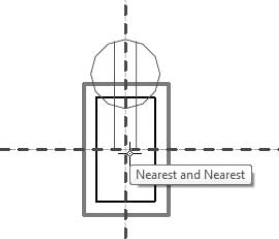
Select the annotation symbol, and click the small box to the far right of the Symbol Offset parameter in the Properties palette (click the Properties button to turn on the palette if needed). In the Associate Family Parameter dialog box, select the Symbol Offset From Wall parameter. Click OK in all open dialog boxes. Save the family.

Load the receptacle family into a project file. Place a receptacle on a vertical host. Select the receptacle, and input a value of 1/4″ (0.6 cm) for the Symbol Offset From Wall parameter. Set the Detail Level setting of your view to Fine. Notice that the symbol is offset from the wall while the component remains hosted inside the wall.
Note that you must use a value for the offset that relates to the actual size of the symbol because the symbol size in the view is determined by the view scale.
The most common type of annotation family is a tag. Tags can be created for any category of Revit model element to report information about the element on your sheet views. A tag family can contain a combination of labels and line work. The Generic Tag.rft family template can be used to create a tag, which can then be categorized for a specific element category. There are also category-specific tag templates that can be used, and you can even use the Generic Annotation.rft template and change its category to a tag. Tags are much more useful than plain text because they will update automatically when the parameters of an element are changed. This is done by using labels in your tag families. Using tags in lieu of text objects will save you editing time and improve coordination.
You can place a label into your annotation family by clicking the Label button on the Text panel of the Home tab. When you click in the drawing area to place the label, the Edit Label dialog box will appear. When using the generic annotation template, any parameters that exist in the family will be listed in the box on the left side. If none exists, you can create one by clicking the Add Parameter button in the lower-left corner of the dialog box. After giving the parameter a name and defining its type and whether it is an instance or type parameter, it will appear in the list.
When you use the generic tag family template, the parameters that are available in the Edit Label dialog box (see Figure 18.17) are parameters common to all Revit model components.
If you categorize your annotation family as a tag for a specific element category, the parameters for that element type will appear in the Edit Label dialog box. Figure 18.18 shows a list of parameters for an electrical equipment tag, including the common parameters. Any shared parameters that you have created for the element category can be added also. See Chapter 19 for more information about shared parameters.
You can assign a parameter to your label by selecting it from the list and clicking the Add Parameter(s) To Label button (with the green arrow).
You can apply a prefix or suffix to the label. These will appear at every location of the tag in your project. The Sample Value column allows you to input a value that will be seen when you are editing the tag family. If a value is given for the parameter while you are editing the tag family, the sample value will be overwritten.
It is possible to add multiple parameters to a single label. Doing so will list the parameter values in the same label object. Selecting the box in the Break column of the Edit Label dialog box will create a hard return after the value of the parameter when it is displayed in the label. This enables you to have a label with multiple lines of text, as shown in Figure 18.19.
If you do not use the Break option, the parameter values will display on a single line. If the single line of parameter values exceeds the bounding box of the label, the values will wrap in the same manner as a text object. You can select the box in the upper-right corner of the Edit Label dialog box to wrap the values between parameters only. This prevents values of a single parameter from ending up on multiple lines. Figure 18.20 shows a multiparameter label on a single line and the same label with its bounding box shortened and the Wrap Between Parameters Only option selected. Notice that the value for the Description parameter did not wrap.
When you click OK to close the Edit Label dialog box, the label will appear with the sample values. The label properties can be edited to display the parameter values as desired. Select the label, and access the Properties palette to edit the alignment of the text and its readability instance properties. The type properties of the label define the text used to display the parameter values. You can assign a color and line weight to the text and define whether the background is transparent or opaque. A tag with a label that has an opaque background will mask out any elements that it is placed over in your project views.
In the Text group of a label's type properties, you can assign a font and text size. You can also make the text bold, italicized, or underlined. You can apply a width factor to the text as well.
Your tag families can be a combination of labels, text, and line work. It is important to position these items around the family's insertion point. Improper placement of items in a tag family will cause inaccuracies in the location of leader lines when the tag is placed into a project. The same drafting tools used to create an annotation family can be used in tag families.
Figure 18.21 shows a duct tag that contains labels and line work. There are two labels so they can be positioned independently. A suffix was added to each label. The line work is positioned at the intersection of the reference planes for proper leader orientation when the tag is used in a project.
When you properly locate the graphics in your tag families, their leaders will maintain connection with the tag graphics regardless of which direction the leader is pointing, as shown in Figure 18.22.
When you place a tag into your project view, there is an option on the Options Bar to orient the tag vertically or horizontally. If you want your tag to align with its associated item, you can select the box in the Rotate With Component parameter. You can find this by clicking the Family Category And Parameters button on the Properties panel of the ribbon when editing the family. Setting your tag family to rotate with its associated component disables the option to set the tag to horizontal or vertical because the tag will align with the component, as shown in Figure 18.23.
- Create symbolic lines and filled regions
Not only is Revit MEP 2011 a modeling application, but it contains the tools necessary to accomplish drafting tasks.
- Master It
Having a good command of the tools available for creating symbols will help you create families that represent your design elements exactly the way you want to see them. What line tool is best suited for duplicating the line work of an imported CAD symbol?
- Use symbols within families for representation on drawings
Given the schematic nature of MEP plans, symbols and annotation objects are important parts of your Revit MEP 2011 workflow, allowing you to represent your model components per your company standards.
- Master It
By having annotation symbols nested into your component families, you can create an accurate 3D model that is displayed schematically on your construction documents. Explain the importance of creating subcategories for the graphics in your annotation families.
- Work with constraints and parameters for visibility control
The parametric modeling capabilities of Revit MEP 2011 make it a powerful BIM solution. These capabilities can be used in annotation families as well.
- Master It
A common scenario for a Revit project is to link consultant files into your project file. Because of this, face-hosted families are often used. Face-hosted components can be attached to either a vertical or horizontal host, so the ability to separate the annotation symbol from the host needs to be created in the annotation family. When using a length parameter to define the offset of a symbol from its host, what value should be input for the parameter when the component family is in a project?
- Use labels to create tags
Tags are the most commonly used annotation families in a project. They are used to report information about objects in a Revit model.
- Master It
The use of labels is a much more effective method than using text objects for keeping documents coordinated.
If your project requires that you show DIA (diameter) after each pipe size tag on your construction documents, how can you accomplish this globally throughout your project?


